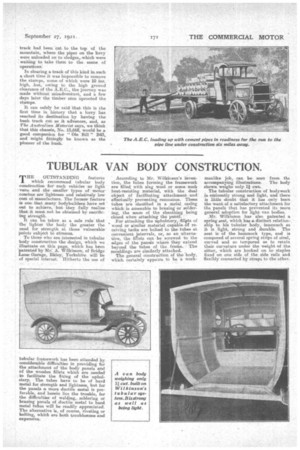TUBULAR VAN BODY CONSTRUCTION.
Page 11

If you've noticed an error in this article please click here to report it so we can fix it.
THE OUTSTANDING features which recommend tubular body construction for such vehicles as light vans, and the smaller types of motor .coachesare lightness and relatively low cost of manufacture. The former feature is one thatmany bodybuilders lave set out to achieve, but they fully realize .that it must not be obtained by sacrificing strength.
• It can be. taken as a safe rule that the lighter • the body the greater the need for strength at those vulnerable points subject to stresses.
• To those who are interested in tubular body construction the-design, which we illustrate on this page, which has been patented by Mr. A. Wilkinson, of Bridge Lane Garage, Ilkley, Yorkshire. Will be of special interest. Hitherto the use of tubular framework has been attended by considerable difficulties in providing for the attachment of the body panels and of the wooden fillets which are needed to facilitate the fixing of the upholstery. The tubes have to be of hard metal for strength and lightness, but for the panels a more ductile metal is preferable, and herein lies the trouble, for the difficulties of welding, soMering or brazing panels of ductile metal to hard metal tubes will be readily appreciated. The alternative is, of course, riveting or bolting, which are both troublesome and expensive. According to Mr. Wilkinson's invention, the tubes forming the framework are filled, with slag wool or some such heat-resisting material-, with the dual object of facilitating -attachment and effectually preventing resonance. These tubes are sheathed in a metal casing which is amenable to brazing or soldering, the seam of the sheathing being closed when attaching the panel.
For attaching the upholstery, filifts of
w or similar mateiial capable of rec.iving tacks are bolted to the tubes at convenient intervals, or, as an alternative, the fillets can -be screwed to the edges of the panels where they extend beyond the tubes of the frame. The mouldings are similarly attached. The general construction of the body, Nvhich certainly apj3ears to be a work manlike job, can be seen from the accompanying illustrations. The body shown weighs only 1.4 cwt.
The tubular construction of bodywork is eminently strong and light, and there is little doubt that it has only been the want, of a satisfactory attachment, for the panels that has prevented its more general adoption for light van bodies.
Mr. Wilkinson has also patented a spring seat, which has a distinct relationship to his tubular body, inasmuch as it is light, strong and durable. The seat is of the hammock type, and is composed of several spring strips of steel, curved and so, tempered as to retain their curvature under the weight of the sitter, which are hooked on to staples fixed on one side of the aide rails and flexibly connected by straps to the other.


































